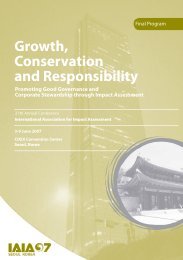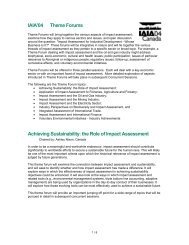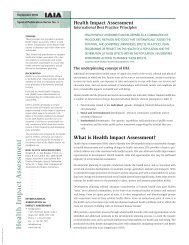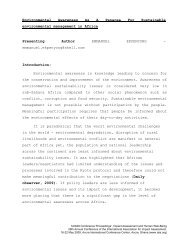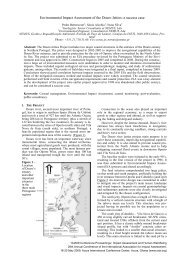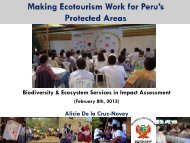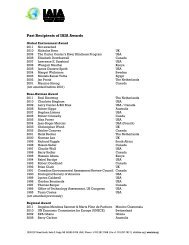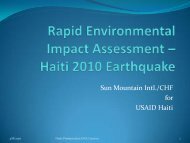Environmental impact assessment in Nigeria - International ...
Environmental impact assessment in Nigeria - International ...
Environmental impact assessment in Nigeria - International ...
You also want an ePaper? Increase the reach of your titles
YUMPU automatically turns print PDFs into web optimized ePapers that Google loves.
<strong>Environmental</strong> <strong>impact</strong> <strong>assessment</strong><br />
<strong>in</strong> <strong>Nigeria</strong>: regulatory background and<br />
procedural framework<br />
Nerry Echefu and .E Akpofure<br />
Case Study 7<br />
ABSTRACT<br />
As a consequence of the illegal dump<strong>in</strong>g of toxic wastes <strong>in</strong> Koko, <strong>in</strong> the<br />
former Bendel State, <strong>in</strong> 1987, the <strong>Nigeria</strong>n Government promulgated the<br />
Harmful Wastes Decree which provides the legal framework for the<br />
effective control of the disposal of toxic and hazardous waste <strong>in</strong>to any<br />
environment with<strong>in</strong> the conf<strong>in</strong>es of <strong>Nigeria</strong>. This was immediately followed<br />
by the creation of a regulatory body, the Federal <strong>Environmental</strong> Protection<br />
Agency (FEPA) <strong>in</strong> 1988. FEPA is charged with the overall responsibility of<br />
protect<strong>in</strong>g and develop<strong>in</strong>g the <strong>Nigeria</strong>n environment. To put this <strong>in</strong>to action<br />
a National Policy on the Environment was developed. This is the ma<strong>in</strong><br />
work<strong>in</strong>g document for the preservation and protection of the <strong>Nigeria</strong>n<br />
environment. States and Local Government Councils were also encouraged<br />
to establish their own environmental regulatory bodies for the purpose of<br />
ma<strong>in</strong>ta<strong>in</strong><strong>in</strong>g good environmental quality as it applies to their particular<br />
terra<strong>in</strong>.<br />
The EIA Decree No. 86 of 1992 is an additional document with the same aim<br />
of protect<strong>in</strong>g the <strong>Nigeria</strong>n environment. It is particularly directed at<br />
regulat<strong>in</strong>g the <strong>in</strong>dustrialization process with due regard to the environment.<br />
By this Decree, no <strong>in</strong>dustrial plan/development/activity fall<strong>in</strong>g under the<br />
FEPA’s mandatory list can be executed without prior consideration of the<br />
environmental consequences of such a proposed action, <strong>in</strong> the form of an<br />
environmental <strong>impact</strong> <strong>assessment</strong>.<br />
The Department of Petroleum Resources (DPR), an arm of the M<strong>in</strong>istry of<br />
Petroleum Resources, recogniz<strong>in</strong>g the national importance of the oil and gas<br />
<strong>in</strong>dustry sector to the cont<strong>in</strong>ued growth of the <strong>Nigeria</strong>n economy and<br />
realiz<strong>in</strong>g that the cont<strong>in</strong>ued exploitation, exploration and production of the<br />
oil resources has serious environmental <strong>impact</strong>s, also decided to set out<br />
comprehensive standards and guidel<strong>in</strong>es to direct the execution of projects<br />
with proper consideration for the environment. The DPR <strong>Environmental</strong><br />
Guidel<strong>in</strong>es and Standards (EGAS) of 1991 for the petroleum <strong>in</strong>dustry is a<br />
comprehensive work<strong>in</strong>g document with serious consideration for the<br />
preservation and protection of the Niger Delta, and thus the <strong>Nigeria</strong>n<br />
See Topic 2<br />
UNEP EIA Tra<strong>in</strong><strong>in</strong>g<br />
Resource Manual<br />
Law, policy and<br />
<strong>in</strong>stitutional<br />
arrangements<br />
63<br />
UNEP EIA Tra<strong>in</strong><strong>in</strong>g Resource Manual ® Case studies from develop<strong>in</strong>g countries
environment, <strong>in</strong> the course of search<strong>in</strong>g for and produc<strong>in</strong>g crude oil. The<br />
EIA tool is also mandatory for a greater part of the oil E&P activities.<br />
But a detailed exam<strong>in</strong>ation of the various statutes, and the framework for<br />
the EIA process <strong>in</strong> particular, and the entire environmental regulatory<br />
process <strong>in</strong> general, reveals that many of the statutes are very much at<br />
variance with <strong>in</strong>tentions, especially as they affect the execution of functions.<br />
There is duplication of functions and overlapp<strong>in</strong>g responsibilities <strong>in</strong> the<br />
processes and procedures guid<strong>in</strong>g the execution of the various <strong>impact</strong><br />
<strong>assessment</strong> tasks. Consequently, serious bottlenecks and bureaucratic<br />
confusion are created <strong>in</strong> the process. The result is a waste of resources,<br />
f<strong>in</strong>ancially and materially.<br />
This paper exam<strong>in</strong>es the statutory regulatory framework for the EIA<br />
process, and the <strong>in</strong>adequacies and mis<strong>in</strong>terpretations of the various statutes,<br />
which have often led to delays <strong>in</strong> the execution of EIAs <strong>in</strong> <strong>Nigeria</strong>. An<br />
attempt will be made to streaml<strong>in</strong>e these various responsibilities through a<br />
reorganization of the regulatory environmental framework. This way, it is<br />
hoped that the bottlenecks and wastage of resources will be elim<strong>in</strong>ated.<br />
INTRODUCTION<br />
<strong>Nigeria</strong> (Africa’s most populous nation), <strong>in</strong>dependent s<strong>in</strong>ce 1960, occupies<br />
an area of 923,768 km 2 with varied climates and seasons. Presently, its<br />
estimated population is over 100 million people.<br />
Prior to oil, agriculture (before 1970) was the economic ma<strong>in</strong>stay. With<br />
f<strong>in</strong>ancial resources available from oil and no development policy, unguided<br />
urbanization and <strong>in</strong>dustrialization took place. Uncontrolled population<br />
growth, desertification, and deforestation led to degradation and<br />
devastation of the environment.<br />
As desirable and necessary as development is, it became an albatross not of<br />
itself but because of the lack of appropriate policies to guide it.<br />
There were several sectoral regulations aimed at controll<strong>in</strong>g environmental<br />
degradation which were unsuccessful due to the absence of effective<br />
sanctions. Economic considerations and fundamental lack of knowledge of<br />
<strong>in</strong>terdependent l<strong>in</strong>kages among development processes and environmental<br />
factors, as well as human and natural resources, resulted <strong>in</strong> an unmitigated<br />
assault on the environment. However, the environment and the need for its<br />
preservation (<strong>in</strong> spite of all efforts by United Nations Environment Program<br />
[UNEP] and <strong>International</strong> Conventions which <strong>Nigeria</strong> ratified), took centre<br />
stage after the momentous and s<strong>in</strong>gular event of the secret dump<strong>in</strong>g of toxic<br />
waste <strong>in</strong> Koko Port, Bendel State (now Delta State) <strong>in</strong> May 1988 by foreign<br />
parties. This was followed by the promulgation of the Harmful Wastes<br />
(Special Crim<strong>in</strong>al Provisions) Act 1990. In its wake, <strong>in</strong>ternational sem<strong>in</strong>ars<br />
and workshops were held <strong>in</strong> Abuja and Lagos and the consensus was for<br />
64<br />
UNEP EIA Tra<strong>in</strong><strong>in</strong>g Resource Manual ® Case studies from develop<strong>in</strong>g countries
appropriate environmental legislation to discourage short-term plans and<br />
‘fire brigade’ approaches to environmental issues.<br />
An <strong>in</strong>stitutional framework was set up to deal with the problems of our<br />
environment. The Federal <strong>Environmental</strong> Protection Agency (FEPA),<br />
established by Decree 58 of 1988 of the same name and amended by Decree<br />
59 of 1992, was given responsibility for control over our environment and<br />
for the development of processes and policies to achieve this. Apart from<br />
publish<strong>in</strong>g the National Policy on the Environment (NPE) <strong>in</strong> 1989, with the<br />
policy goal of achiev<strong>in</strong>g susta<strong>in</strong>able development, it published other sectoral<br />
regulations <strong>in</strong>clud<strong>in</strong>g the National <strong>Environmental</strong> Protection (Pollution<br />
Abatement <strong>in</strong> Industries and Facilities Generat<strong>in</strong>g Wastes) Regulation 1991<br />
where<strong>in</strong> EIA was made obligatory only when so demanded by FEPA and<br />
compliance was with<strong>in</strong> 90 days of such demand. However <strong>in</strong> the oil <strong>in</strong>dustry<br />
the pr<strong>in</strong>cipal legislation is the Petroleum Act 1969 and all derivative<br />
regulations charged DPR among others with pollution abatement.<br />
States and Local Government Councils (LG) which comprise the second and<br />
third tiers of government were encouraged under Decree 59 of 1992 to set up<br />
their own environmental protection agencies.<br />
Separate EIA legislation, the EIA Decree 86 of 1992, was promulgated<br />
establish<strong>in</strong>g FEPA as the apex regulator, mak<strong>in</strong>g EIA mandatory for all<br />
developmental purposes (although with some exceptions). Under it FEPA<br />
has published various sectoral EIA procedures together with EIA procedural<br />
guidel<strong>in</strong>es <strong>in</strong> 1995.<br />
INSTITUTIONAL AND REGULATORY FRAMEWORK<br />
Prior to the establishment of the FEPA there were sectoral environmental<br />
regulations with various significant responsibilities relat<strong>in</strong>g to<br />
environmental protection and improvement. Also <strong>in</strong> existence were<br />
commissions with advisory capacity <strong>in</strong> environmental matters and<br />
environmental NGOs.<br />
Due to various activities and the complex comb<strong>in</strong>ation of <strong>in</strong>terdependent<br />
operations of the oil <strong>in</strong>dustry it, more than any other sector, adversely<br />
affects the environment.<br />
In the oil <strong>in</strong>dustry DPR adopted remedial, though <strong>in</strong>adequate, enforcement<br />
tools which <strong>in</strong>cluded compliance monitor<strong>in</strong>g and the issu<strong>in</strong>g of<br />
permits/licences. Studies <strong>in</strong>dicated the extent of devastation the oil <strong>in</strong>dustry<br />
has caused to aquatic and terrestrial ecosystems and cultural and historical<br />
resources. This, coupled with the community’s dissatisfaction and agitation,<br />
especially <strong>in</strong> the Ogoni and Ijaw homelands, re<strong>in</strong>forced the need for the<br />
sector to plan, protect and enhance prudently the environmental resources<br />
for a better environment.<br />
65<br />
UNEP EIA Tra<strong>in</strong><strong>in</strong>g Resource Manual ® Case studies from develop<strong>in</strong>g countries
The need to control new <strong>in</strong>stallations or projects with capacity to degrade<br />
the environment was also identified. This compelled DPR to issue updated<br />
<strong>Environmental</strong> Guidel<strong>in</strong>es and Standards (EGAS) <strong>in</strong> 1991 provid<strong>in</strong>g for the<br />
first time, together with pollution abatement technology, guidel<strong>in</strong>es and<br />
standards and monitor<strong>in</strong>g procedures, a mandatory EIA report as<br />
enforcement tool. There are other regulatory bodies with<strong>in</strong> the sector.<br />
FEPA, charged with the protection and development of the environment,<br />
prepared a comprehensive national policy, <strong>in</strong>clud<strong>in</strong>g procedures for<br />
environmental <strong>impact</strong> <strong>assessment</strong> for, amongst others, all development<br />
projects. Enforcement powers were also prescribed. In the National Policy<br />
on the Environment (NPE), FEPA adopted a strategy that guarantees an<br />
<strong>in</strong>tegrated holistic and systemic view of environmental issues that leads to<br />
prior environmental <strong>assessment</strong> of proposed activities.<br />
The other regulators <strong>in</strong>clud<strong>in</strong>g State EPAs (unnecessarily charged with<br />
similar and identical responsibilities to those of FEPA) rather than<br />
cooperat<strong>in</strong>g with FEDA underm<strong>in</strong>e its efforts as they demand a role <strong>in</strong> the<br />
state of the environment with<strong>in</strong> their areas. This occurs particularly where<br />
FEPA <strong>in</strong>volves them only at the review stage <strong>in</strong> the EIA process. This creates<br />
a lot of confusion and bureaucratic delays <strong>in</strong> implement<strong>in</strong>g the EIA process<br />
lead<strong>in</strong>g to enormous cost and unnecessary waste of time.<br />
ENVIRONMENTAL IMPACT ASSESSMENT SYSTEM<br />
Features<br />
The pr<strong>in</strong>cipal legislation is Decree 86 of 1992 which made EIA mandatory<br />
for both public and private sectors for all development projects. It has three<br />
goals and thirteen pr<strong>in</strong>ciples for how these are to be achieved. The goals are:<br />
• Before any person or authority takes a decision to undertake or<br />
authorize the undertak<strong>in</strong>g of any activity that may likely or<br />
significantly affect the environment, prior consideration of its<br />
environmental effects should first be taken.<br />
• To promote the implementation of appropriate procedures to realize<br />
the above goal.<br />
• To seek the encouragement of the development of reciprocal<br />
procedures for notification, <strong>in</strong>formation exchange and consultation <strong>in</strong><br />
activities likely to have significant trans-state (boundary)<br />
environmental effects.<br />
FEPA categorizes mandatory study activities <strong>in</strong>to three categories. (see<br />
Figure 1 below):<br />
Category 3 activities have beneficial <strong>impact</strong>s on the environment. For<br />
Category 2 activities (unless with<strong>in</strong> the <strong>Environmental</strong>ly Sensitive Area) full<br />
EIA is not mandatory, while Category 1 activities require full and<br />
mandatory EIA. Either list<strong>in</strong>g or an <strong>in</strong>itial environmental evaluation (IEE)<br />
system is used to determ<strong>in</strong>e projects requir<strong>in</strong>g full EIA.<br />
66<br />
UNEP EIA Tra<strong>in</strong><strong>in</strong>g Resource Manual ® Case studies from develop<strong>in</strong>g countries
Figure 1: Category of mandatory EIA studies<br />
67<br />
UNEP EIA Tra<strong>in</strong><strong>in</strong>g Resource Manual ® Case studies from develop<strong>in</strong>g countries
The m<strong>in</strong>imum requirement of an EIA report <strong>in</strong>cludes not only the<br />
description of the activity, potential affected environment, practical<br />
alternative, and <strong>assessment</strong> of likely or potential environmental <strong>impact</strong>s, but<br />
also identification and description of the mitigation measures, <strong>in</strong>dication of<br />
gaps <strong>in</strong> knowledge, notification of trans-state adverse environmental effects<br />
(if any) and a brief non-technical summary of all the above <strong>in</strong>formation.<br />
Impartial and written FEPA decisions <strong>in</strong>dicat<strong>in</strong>g mitigation measures based<br />
on a detailed exam<strong>in</strong>ation of environmental effects identified <strong>in</strong> the<br />
environmental <strong>impact</strong> <strong>assessment</strong> (after an opportunity with<strong>in</strong> an<br />
appropriate period had been given to the stakeholders and the public for<br />
their comments) is made available to <strong>in</strong>terested person(s) or group(s). It<br />
provides, where necessary, that potentially affected States or Local<br />
Government Areas are notified.<br />
PROCESS AND PROCEDURAL FRAMEWORK<br />
The EIA process is the various stages a project undergoes from proposal to<br />
approval for implementation, result<strong>in</strong>g <strong>in</strong> the issu<strong>in</strong>g of an <strong>Environmental</strong><br />
Impact Statement (EIS) and certificate.<br />
The term encompasses several stages, viz:<br />
• determ<strong>in</strong><strong>in</strong>g if FEPA environmental laws/regulations have been<br />
triggered;<br />
• screen<strong>in</strong>g a project for potential environmental effects;<br />
• scop<strong>in</strong>g to determ<strong>in</strong>e the spatial and temporary dimension of<br />
environmental effects;<br />
• carry<strong>in</strong>g out detailed base l<strong>in</strong>e studies to determ<strong>in</strong>e the environmental<br />
condition prior to project implementation;<br />
• prepar<strong>in</strong>g a detailed <strong>assessment</strong> report;<br />
• carry<strong>in</strong>g out a panel review of the EIA report if this is necessary; and<br />
• obta<strong>in</strong><strong>in</strong>g authorization/approval, where appropriate.<br />
For FEPA, the Director General/Chief Executive is the responsible officer.<br />
The National Procedural Guidel<strong>in</strong>es show practical steps from project<br />
conception to commission<strong>in</strong>g (see Figure 2). The steps are:<br />
• project proposal<br />
• <strong>in</strong>itial environmental exam<strong>in</strong>ation (IEE)/prelim<strong>in</strong>ary <strong>assessment</strong><br />
• screen<strong>in</strong>g<br />
• scop<strong>in</strong>g<br />
• EIA study<br />
• review<br />
• decision mak<strong>in</strong>g<br />
• monitor<strong>in</strong>g, and<br />
68<br />
UNEP EIA Tra<strong>in</strong><strong>in</strong>g Resource Manual ® Case studies from develop<strong>in</strong>g countries
• audit<strong>in</strong>g.<br />
The proponent <strong>in</strong>itiates the process <strong>in</strong> writ<strong>in</strong>g to the responsible officer. A<br />
notification form is duly completed with all relevant <strong>in</strong>formation on the<br />
proposal. Us<strong>in</strong>g the criteria of :<br />
• magnitude – probable severity of each potential <strong>impact</strong>;<br />
• prevalence/extent and scope – extent to which the <strong>impact</strong> may<br />
eventually extend;<br />
• duration and frequency – is activity short term, long term or<br />
<strong>in</strong>termittent;<br />
• risks – probability of serious environmental effects;<br />
• significance/importance – value attached to a specified area; and<br />
• mitigation – measures available for associated and potential<br />
environmental effects<br />
FEPA does <strong>in</strong>ternal screen<strong>in</strong>g (IEE) to determ<strong>in</strong>e the project’s category<br />
under the mandatory study activities list.<br />
Where no adverse environmental effects exist, the EIA is issued and the<br />
project commences with appropriate mitigation and monitor<strong>in</strong>g measures.<br />
Otherwise with<strong>in</strong> ten work<strong>in</strong>g days of receipt of the proposal, the screen<strong>in</strong>g<br />
report is sent to the proponent for scop<strong>in</strong>g and the preparation of Terms of<br />
Reference (ToR). The ToR embodies the scope of the proposed EIA study<br />
and this is exam<strong>in</strong>ed and the scope of the study def<strong>in</strong>ed accord<strong>in</strong>gly by<br />
FEPA. The proponent carries out the study, generally us<strong>in</strong>g consultants, and<br />
the draft EIA report <strong>in</strong> 15 copies is submitted to the responsible officer. For<br />
this draft report to be complete it must as an annex record the results of<br />
public participation <strong>in</strong> a public form.<br />
With<strong>in</strong> 15 work<strong>in</strong>g days of the receipt of the draft report, FEPA concludes<br />
evaluation of the draft and determ<strong>in</strong>ation of the review method which it<br />
communicates to the proponent <strong>in</strong> writ<strong>in</strong>g. The four methods are:<br />
• In-house review.<br />
• Panel review (sitt<strong>in</strong>g may be public).<br />
• Public review – an elaborate display of the report for 21 work<strong>in</strong>g days<br />
with appropriate display venues chosen by FEPA for the convenience<br />
of the public stakeholders and communities. Through newspaper<br />
advertisement FEPA <strong>in</strong>vites <strong>in</strong>terested groups /persons to participate.<br />
• Mediation.<br />
With<strong>in</strong> one month of the review process, review comments are furnished to<br />
the proponent. In this review stage, the public participates only when<br />
FEPA’s chosen method of review guarantees its participation.<br />
The f<strong>in</strong>al EIA report, address<strong>in</strong>g and proffer<strong>in</strong>g answers to review<br />
comments, is submitted with<strong>in</strong> six months to the responsible officer. At this<br />
early stage, and on mutual agreement, FEPA and the proponent set<br />
69<br />
UNEP EIA Tra<strong>in</strong><strong>in</strong>g Resource Manual ® Case studies from develop<strong>in</strong>g countries
conditions establish<strong>in</strong>g a follow-up program (mitigation, compliance and<br />
monitor<strong>in</strong>g plan), a monitor<strong>in</strong>g strategy and audit procedure. A ‘no project’<br />
decision is communicated to the proponent if the review comments are<br />
adverse and/or improperly addressed <strong>in</strong> the f<strong>in</strong>al report and the f<strong>in</strong>al EIA<br />
report is unsatisfactory. The decision-mak<strong>in</strong>g body is the FEPA technical<br />
committee chaired by the Director General/Chief Executive.<br />
With<strong>in</strong> one month of the receipt of a f<strong>in</strong>al EIA report which has been<br />
adjudged as satisfactory, the committee approves and issues the<br />
<strong>Environmental</strong> Impact Statement (EIS) followed by certification by the<br />
responsible officer complete with appropriate conditions and with a validity<br />
period. Armed with the certificate, the proponent commences the project<br />
subject to the conditions and specifications conta<strong>in</strong>ed <strong>in</strong> the EIS. If the<br />
project is not commissioned with<strong>in</strong> the validity period on the certificate a<br />
revised and updated EIA report becomes necessary for revalidation.<br />
The progress of the project is monitored to ensure compliance with all<br />
conditions and mitigation measures. <strong>Environmental</strong> audit, assess<strong>in</strong>g both<br />
positive and negative <strong>impact</strong>s of the project, is carried out periodically. In its<br />
exercise of discretionary powers, FEPA refers any project likely to cause<br />
significant environmental effects that may not be mitigated (or where public<br />
concern about the project warrants it) to the FEPA council for mediation or<br />
panel review.<br />
The EIA study team usually is a multi-discipl<strong>in</strong>ary panel of experts and the<br />
report is prepared us<strong>in</strong>g a systematic, <strong>in</strong>terdiscipl<strong>in</strong>ary approach<br />
<strong>in</strong>corporat<strong>in</strong>g all relevant analytical discipl<strong>in</strong>es to provide mean<strong>in</strong>gful and<br />
factual data, <strong>in</strong>formation and analyses. The presentation of data should be<br />
clear and concise, yet <strong>in</strong>clude all facts necessary to permit <strong>in</strong>dependent<br />
evaluation and appraisal of both the beneficial and adverse environmental<br />
effects of alternative actions. The detail provided should be commensurate<br />
with the extent and expected <strong>impact</strong> of the action and the amount of<br />
<strong>in</strong>formation required at the particular level of decision-mak<strong>in</strong>g.<br />
FEPA certifies consultants and reviewers. Only research <strong>in</strong>stitutions and<br />
limited liability companies of proven competence are so certified.<br />
Sadly <strong>in</strong> the oil sector, there is confusion as a result of multiple regulators.<br />
The Department of Petroleum Resources and the State <strong>Environmental</strong><br />
Protection Agencies have enabl<strong>in</strong>g <strong>in</strong>struments which permit them to<br />
conduct EIA without limitation. DPR’s <strong>in</strong>strument is its regulation, EGAS<br />
1991, which empowered it to conduct EIA, but there is no legislation so<br />
empower<strong>in</strong>g it directly. The States <strong>in</strong>struments are subject to Federal<br />
enactment and other than <strong>in</strong>ord<strong>in</strong>ate show of relevance they are to merely<br />
monitor the process for, and on behalf of, FEPA. FEPA should as early as<br />
possible <strong>in</strong>form the relevant State EPA at its secretariat stage.<br />
70<br />
UNEP EIA Tra<strong>in</strong><strong>in</strong>g Resource Manual ® Case studies from develop<strong>in</strong>g countries
CONCLUSION AND RECOMMENDATIONS<br />
We acknowledge that <strong>Nigeria</strong> has taken serious steps to develop effective<br />
environmental strategies by the promulgation of the EIA Decree and all the<br />
procedural guidel<strong>in</strong>es. Yet there are too many regulators with similar and<br />
identical responsibilities. Harmonization and clear allocation of<br />
responsibilities has become necessary. FEPA is the apex regulator, and DPR<br />
<strong>in</strong> reliance on regulations can not usurp the responsibility of FEPA nor the<br />
State EPA when under our canon of legal <strong>in</strong>terpretation, any Edict (law) <strong>in</strong><br />
conflict with the Decree (Act) to the extent of the conflict is void. Recognition<br />
of this, and an eschew<strong>in</strong>g of rivalries among the adm<strong>in</strong>istrators, will<br />
encourage co-operation among them.<br />
To be relevant the regulators (adm<strong>in</strong>istrators) should be better supported<br />
and, for effective compliance monitor<strong>in</strong>g and enforcement, stiffer sanctions<br />
and penalties should be prescribed and strictly adhered to. This way<br />
environmental requirements will be met and ma<strong>in</strong>ta<strong>in</strong>ed. Compliance<br />
should be tied to renewal of licenses and consents and proponents should<br />
ensure that staff are highly motivated with adequate equipment and<br />
capacity build<strong>in</strong>g programs vigorously pursued not only by the<br />
adm<strong>in</strong>istrators but also the proponents. The adm<strong>in</strong>istrators should <strong>in</strong>vest<br />
more <strong>in</strong> capacity build<strong>in</strong>g, staff motivation and provision of conducive work<br />
environments together with the necessary facilities. The government <strong>in</strong> this<br />
regard should make funds available to the secretariat. Otherwise, they<br />
become exposed to monetary <strong>in</strong>ducements leav<strong>in</strong>g compliance <strong>in</strong> the hands<br />
of the proponent. This is unhealthy. With basic knowledge of their<br />
responsibilities they could become more efficient and effective <strong>in</strong> improv<strong>in</strong>g<br />
the quality of EIA report.<br />
The adm<strong>in</strong>istrators should set up a databank and provide basel<strong>in</strong>e data. The<br />
EIA process is <strong>in</strong> transition <strong>in</strong> <strong>Nigeria</strong>, and may take years or even decades<br />
to develop and this depends on a strong and cont<strong>in</strong>uous political<br />
commitment at the highest levels with<strong>in</strong> and among our adm<strong>in</strong>istrators, on<br />
the active role of an <strong>in</strong>formed and <strong>in</strong>volved public and on some pragmatic<br />
programs of national action and sub-regional and regional co-operation<br />
(Kampala Declaration 1989).<br />
The natural consequence, therefore, is that experience is <strong>in</strong>creas<strong>in</strong>g and the<br />
need for sufficient <strong>in</strong>formation <strong>in</strong> the transition period is met, as has recently<br />
been undertaken by some oil companies, government and <strong>in</strong>ternational<br />
organizations <strong>in</strong> the Niger Delta <strong>Environmental</strong> Survey (NDES). This will<br />
provide environmental basel<strong>in</strong>e data for the area. We hope that it extends to<br />
other areas of the Federation.<br />
71<br />
UNEP EIA Tra<strong>in</strong><strong>in</strong>g Resource Manual ® Case studies from develop<strong>in</strong>g countries
PROPONENT<br />
FEASIBILITY STUDY OR PROJECT PROPOSAL<br />
FEPA EIA SECRETARIAT<br />
INITIAL ENVIRONMENTAL EVALUATION<br />
MANDATORY PROJECTS<br />
OTHERS<br />
CLASSIFIED PROJECTS<br />
EXCLUDED PROJECTS<br />
PRELIMINARY ASSESSMENT<br />
SCREENING<br />
SCOPING<br />
NO EIA REQUIRED<br />
DRAFT EIA REPORT<br />
PUBLIC HEARING<br />
REVIEW PANEL<br />
REVIEW REPORT<br />
PROPONENT<br />
MEDIATION<br />
Not approved<br />
FINAL EIA REPORT<br />
TECHNICAL COMMITTEE<br />
Decision mak<strong>in</strong>g committee<br />
approved<br />
ENVIRONMENTAL IMPACT STATEMENT (EIS) AND CERTIFICATION<br />
ENVIRONMENTAL IMPACT MONITORING<br />
PROJECT IMPLEMENTATION<br />
COMMISSION<br />
AUDIT<br />
Figure 2: Flow chart of FEPA EIA procedures<br />
Public participation is not statutorily protected yet current realities have<br />
encouraged public <strong>in</strong>volvement as the communities have become aware of<br />
the need to protect the environment. Though largely illiterate and poor, and<br />
thereby vulnerable to monetary <strong>in</strong>ducement <strong>in</strong> the hands of unscrupulous<br />
proponents, nevertheless their knowledge of the locality can enhance the<br />
process. In this regard the law should be reviewed.<br />
FEPA usually <strong>in</strong>volves the State EPAs only at the review stage and it has<br />
been observed that this angers them, prompt<strong>in</strong>g a demand for a repeat of the<br />
EIA study by the proponent, with its attendant resources wastes. Often they<br />
refused to attend public forums as FEPA officials are usually absent from<br />
these. The illiterate public, left to the mercy of the proponent, is misled. It is<br />
suggested that FEPA should <strong>in</strong>volve the relevant State EPA at the secretariat<br />
stage i.e. when the proponent submits the proposal so as to enable them to<br />
monitor and participate actively <strong>in</strong> the entire process and not only <strong>in</strong> the<br />
review. In this regard, on receipt of the project proposal, FEPA should send<br />
72<br />
UNEP EIA Tra<strong>in</strong><strong>in</strong>g Resource Manual ® Case studies from develop<strong>in</strong>g countries
a copy to the other relevant agencies liais<strong>in</strong>g effectively from that stage and<br />
<strong>in</strong>volv<strong>in</strong>g the proponent. The proponent should provide assurance that the<br />
required regulations are met, us<strong>in</strong>g concepts of self-regulation, goal-sett<strong>in</strong>g<br />
and negotiated agreements to complement prescriptive legislation.<br />
The process of accreditation by FEPA, apart from be<strong>in</strong>g time-consum<strong>in</strong>g,<br />
cumbersome and arduous, encourages fraudulent companies to engage the<br />
services of mercenaries for the purpose of answer<strong>in</strong>g <strong>in</strong>terview questions.<br />
We suggest that a more pragmatic and result-oriented approach should be<br />
adopted with sporadic checks of such companies. Some States <strong>in</strong>sist on their<br />
own accreditation exercise despite FEPA’s creat<strong>in</strong>g multiple accreditation.<br />
We suggest that for the process of accreditation to be accepted by all States,<br />
which should be <strong>in</strong>volved <strong>in</strong> the exercise. The efforts of the environmental<br />
NGOs ought to be stepped up <strong>in</strong> the area of cont<strong>in</strong>uous capacity build<strong>in</strong>g of<br />
their members so that they can participate efficiently and mean<strong>in</strong>gfully <strong>in</strong><br />
public forums thereby enhanc<strong>in</strong>g the quality of the EIA report and the<br />
decisions taken aris<strong>in</strong>g from them.<br />
The Law Reform Commission and Federal M<strong>in</strong>istry of Justice <strong>in</strong> conjunction<br />
with the States, environmental NGOs and <strong>in</strong>terested groups and companies,<br />
should develop an <strong>in</strong>tegrated, co-ord<strong>in</strong>ated and comprehensive legislation<br />
on the environment, remov<strong>in</strong>g rivalries, bureaucratic bottlenecks and areas<br />
of overlapp<strong>in</strong>g, duplication and confusion.<br />
We venture, however to add that the EIA process <strong>in</strong> <strong>Nigeria</strong> if adequately<br />
handled, with the consultants <strong>in</strong>volved <strong>in</strong> capacity build<strong>in</strong>g and the<br />
adm<strong>in</strong>istrators highly motivated and with the Government mak<strong>in</strong>g funds<br />
available, will result <strong>in</strong> environmental issues be<strong>in</strong>g built <strong>in</strong>to taxation, prior<br />
approval procedures for <strong>in</strong>vestment, technology choices and <strong>in</strong>to all<br />
components of development policies (Kontagora 1991).<br />
LIST OF RELEVANT PUBLISHED PAPERS AND OTHER SOURCE<br />
MATERIAL<br />
A<strong>in</strong>a E. O. A. 1989, New Direction for Susta<strong>in</strong>able Development <strong>in</strong> <strong>Nigeria</strong>, A paper<br />
delivered at the <strong>International</strong> Workshop on the Environment and Susta<strong>in</strong>able<br />
Development <strong>in</strong> <strong>Nigeria</strong> at the NICON-NOGA HILTON Hotel, Abuja.<br />
Achiev<strong>in</strong>g Susta<strong>in</strong>able Development <strong>in</strong> <strong>Nigeria</strong>. National Report for the United Nations<br />
Conference on Environment and Development Rio de Janeiro, Brazil (1992).<br />
Amid. D. Adekunle 1998, In Search of Partners <strong>in</strong> a Context of Multiple Regulators:<br />
The Perspective of an Operator <strong>in</strong> <strong>Nigeria</strong> Oil Industry. A paper presented at the<br />
<strong>International</strong> sem<strong>in</strong>ar on the Petroleum Industry and the <strong>Nigeria</strong>n Environment<br />
Abuja Sheraton Hotel & Towers .<br />
Anderson Brian 1996 , <strong>Environmental</strong> Issues and Management Strategies. Keynote<br />
73<br />
UNEP EIA Tra<strong>in</strong><strong>in</strong>g Resource Manual ® Case studies from develop<strong>in</strong>g countries
address at the <strong>International</strong> sem<strong>in</strong>ar on the Petroleum Industry and the <strong>Nigeria</strong>n<br />
Environment. Port Harcourt.<br />
Ojile M. O. 1998, Answers to Technical Qualify<strong>in</strong>g Questions for the EIA Studies.<br />
Raph Mulders 1997 The State of <strong>Environmental</strong> Impact Assessment <strong>in</strong> the Develop<strong>in</strong>g<br />
Countries. The Hague.<br />
Delta State <strong>Environmental</strong> Protection Agency (DELSEPA) Edict No. 5 1997.<br />
Rivers State <strong>Environmental</strong> Protection Agency (RSEPA) Edict No. 2 1994.<br />
Department of Petroleum Resources (DPR), <strong>Environmental</strong> Guidel<strong>in</strong>es and Standards for<br />
the Petroleum Industry <strong>in</strong> <strong>Nigeria</strong> (1991).<br />
Federal <strong>Environmental</strong> Protection Agency (FEPA) Decree 59, 1992.<br />
National Policy on the Environment (1989).<br />
<strong>Environmental</strong> Impact Assessment Decree 86, 1992.<br />
FEPA <strong>Environmental</strong> Impact Assessment procedural Guidel<strong>in</strong>es (1995).<br />
United Nations Environment Program, <strong>Environmental</strong> law Guidel<strong>in</strong>es and Pr<strong>in</strong>ciples<br />
<strong>Environmental</strong> Impact Assessment (1991).<br />
The author:<br />
Nerry Echefu<br />
Echefu, Echefu and Co<br />
25 Beckweri Street, D/L<strong>in</strong>e<br />
Port Harcourt<br />
NIGERIA.<br />
Key words<br />
EIA process<br />
legislative<br />
framework<br />
<strong>in</strong>stitutional<br />
support<br />
74<br />
UNEP EIA Tra<strong>in</strong><strong>in</strong>g Resource Manual ® Case studies from develop<strong>in</strong>g countries




![Session Report [PDF] - International Association for Impact Assessment](https://img.yumpu.com/22416146/1/190x245/session-report-pdf-international-association-for-impact-assessment.jpg?quality=85)
![Session Report [PDF] - International Association for Impact Assessment](https://img.yumpu.com/22416140/1/184x260/session-report-pdf-international-association-for-impact-assessment.jpg?quality=85)
